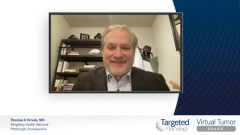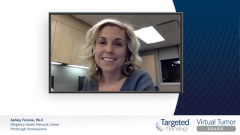
Unmet Needs and Future Directions for Ovarian Cancer
Thomas C. Krivak MD, John K. Chan, MD, and Cecelia H. Boardman, MD, share insight on recent updates to maintenance therapy, unmet needs, and the future treatment landscape for ovarian cancer.
Episodes in this series

Thomas C. Krivak, MD: To wrap some things up with the Virtual Tumor Board, we had 3 great cases. Does anybody care to touch on some of the quality data, quality-adjusted data from PRIMA, or SOLO, or the Vigil trial, or OReO, anything that you see that, to me, within maintenance therapy you found interesting? John, go ahead.
John K. Chan, MD: Yes, just to mention the OReO trial, when ASCO [American Society of Clinical Oncology] came out with their guidelines regarding use of PARP after PARP, this was the trial that we were all looking for to give us some guidance in terms of is it OK to re-expose patients with PARP inhibitors. And some folks have thought that the margin of benefit associated with the OReO trial was quite small, and that was truly a positive study. Overall, that they show that the ability to reuse PARP inhibitor on these patients is safe. Based the hazard ratios, they did see a difference and it was statistically important with a hazard ratio of about 0.6.
We wish that the magnitude would be larger, particularly in the patients who have BRCA1 mutations. But it does change what I’ve been doing and how I offer my patients olaparib [Lynparza] in the recurrent setting or another PARP inhibitor in the recurrent setting because when these patients, on average, are getting let’s say 48 months median in the SOLO1 trial, 37 months associated with, or over 20 months associated with niraparib [Zejula]. And to deny that re-treatment and on the magnitude of benefit that they got 2 years ago, maybe 4 years ago, it’s something that we should continue to offer these patients with the re-treatment, just like we offer patients re-treatment with platinum. We re-treat with Taxol and Avastin in the AURELIA study. All these were re-therapy drugs. Why should PARP inhibitors be any different?
Thomas C. Krivak, MD: I agree with you wholeheartedly. The AURELIA trial to me solidified that a concept is safe, it’s effective. We may have not seen the deltas, but we had strong hazard ratios because a lot of these people were probably receiving PARP in third-, fourth-, fifth-, sixth-line maintenance. I thought it was a great study that showed that it’s going to be safe for us to rechallenge these patients. I think PRIMA and SOLO, the quality-adjusted data and everything, those were all encouraging that patients can tolerate these medications for a long period of time. Cecelia, any thoughts about the 4 results upfront; Vigil, SOLO1, PRIMA, and some of the data from that OReO?
Cecelia H. Boardman, MD: Yes. One of the big things we hear arguments from some of our colleagues about, “Oh, I don’t want to burn all my bridges and I don’t want to use everything upfront. I want to save this for later.” But we know that our response rates and our duration of response is best, particularly with PARP, when we use it sooner rather than later. But I do like the fact that particularly the OReO data says to us if you’ve responded to PARP and you’ve had a PARP-free interval, just like with platinum, you can rechallenge or re-treat with PARP and still see benefit. We’re not burning a bridge by using it in the frontline, and hopefully we don’t ever need to use treatment again. But I had a patient years ago who was on 1 of the early NCI [National Cancer Institute] trials with olaparib and she demonstrated that in her own journey that you could respond to olaparib after olaparib. And it confirms what my clinical suspicion was and what we’ve tried to do for our patients.
Thomas C. Krivak, MD: Excellent. What do you guys see as the most critical unmet need for ovarian cancer? We saw some positive data. Obviously, we have still many areas that we can improve. But where do you guys see some of the significant unmet needs?
John K. Chan, MD: There are patients that may be cured from chemotherapy. There are patients that will get cures with recurrent treatment with these PARPs. And all of us have a handful of these patients that can get extended benefit from use of PARP for 4 or 5 years. We’ve never seen that in our career. We’ve never seen short progression-free survival benefits and then you put them on chemotherapy and a PARP, and this time they’re 4 years out. These drugs are changing the biology of our cancer that we deal with. To refine and truly do personalized therapy, to find these, whether it’s upfront cures without any maintenance therapy or recurrent treatment of specific drugs and combinations that will give them that long duration of response and remission, that’s the key—is to be able to get even better at our ability to target these treatments and to use it in unique patients will get that dramatic benefit that we hope to see.
Cecelia H. Boardman, MD: Yes. I would agree with you, John. And clearly, I must be a little older than you because I lived the era of cytoxan/cisplatin. I lived the era of the introduction of taxanes in recurrent setting and then in the frontline setting of ovarian cancer during my residency and I saw the difference that it made. And this is as to me life-changing data, the use of PARP inhibitors in the frontline setting. I mean, it really, it gives us that additional significant benefit. Challenging our colleagues to embrace maintenance therapy is an important concept. We are surgeons. We think we cure ovarian cancer with surgery, but looking at drilling down the molecular markers and putting that personalized approach and saying these are patients that potentially could be cured with the addition of maintenance treatment is important.
Thomas C. Krivak, MD: You guys hit on a lot of things. I have the best job going. I get to meet great people in the clinic. I get to work with great people in my office. And I get to work with great colleagues like both of you, John and Cecelia. I think GYN [gynecologic] oncology has done a great job through the NRG of really developing these medications in combination with pharma, our colleagues in pharma that have sponsored a lot of these trials that work with the NRG and GOG [Gynecologic Oncology Group]. We’re a very fortunate group with that. We think about some of these unmet needs, such as treating homologous recombination proficient cancer. The first trial combination of PARPs with immunotherapy, combination of WEE1 inhibitors, ATR [ataxia telangiectasia and Rad3-related kinase], we’re all there. Those studies are out there.
I know that when we go to the NRG meeting, I’ll probably see both of you and there’s going to be hopefully more concepts. The GOG Foundation has done an outstanding job with Dr Moore and Dr Herzog kind of leading the way to make sure that we’re invested in all these combination therapies and looking at molecular medicine. Hopefully our next upfront clinical trials look at a molecular breakdown to help tease out some of these subgroups of patients.
I want to thank you all for your input today, and this has been a wonderful conversation and discussion. I would like to thank the panel for all the thoughtful comments throughout these cases and a lively discussion. I’d like to thank the viewing audience as well for joining us for Targeted Oncology® Virtual Tumor Board presentation. I all hope here that today’s discussion was a valuable use of your time and you’ve acquired some practical knowledge that you could take back to the clinic. Any other thoughts from the group? Thank you so much.
Transcript Edited for Clarity











































